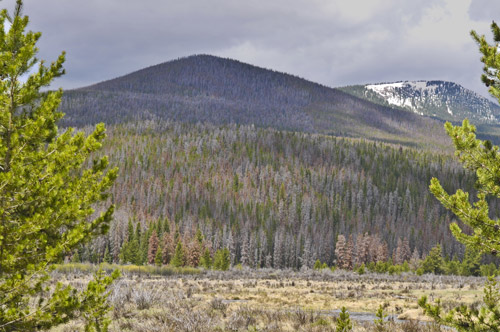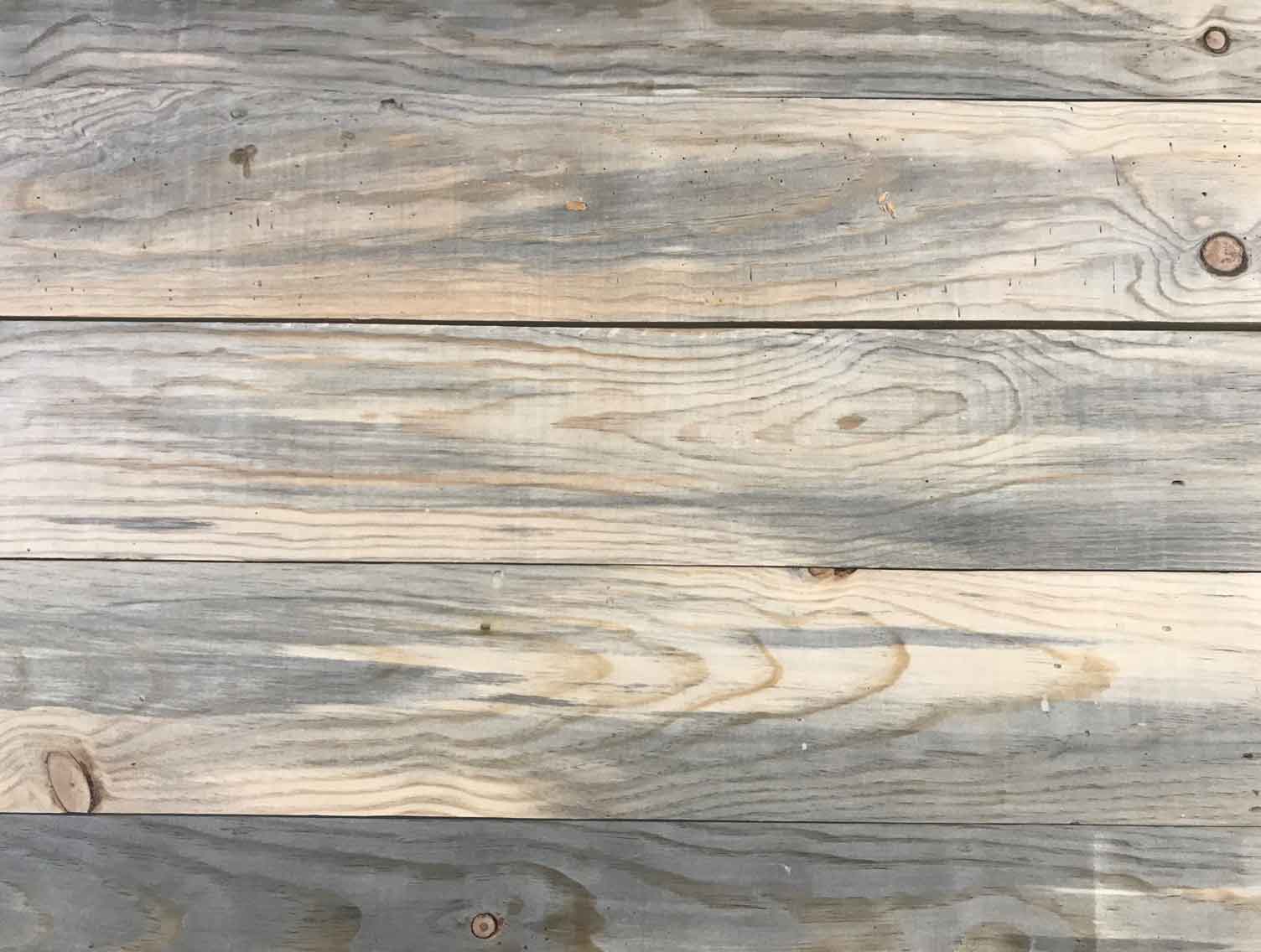Return To Blog
Beetle Kill Blue Stain Pine Lumber in Fort Collins
January 3, 2018
The mountain pine beetle is a species of bark beetle native to western North America, inhabiting forests from Mexico through the western United States and into the central portions of the Canadian province, British Columbia. An integral insect in the forests’ ecosystem, mountain pine beetles feed on older trees assisting in the youthful development of a natural forest state, allowing the maturation of younger saplings while preventing older, dead or decaying trees from robbing them of needed nutrients.
A rise in the earth’s average temperature over the past few years coupled with extended dry conditions and plenty of lodgepole pine trees have caused an epidemic and feeding frenzy of sorts from the mountain pine beetle community. The beatles lay eggs underneath the bark of an infected tree while introducing a blue stain fungus onto its’ new home. The fungus provided by colonization inhibits the housed tree from transporting water and essential nutrients inside and around to all areas of the tree, ultimately resulting in an untimely death for the endangered host.
Typically within two weeks, an attacked tree will be rendered lifeless as the beatles continue their attack while living out their life cycle. Once an attack is rendered a signal is sent to surrounding pine beetles in the area drawing even more insects to a specific tree under attack. Mountain pine beetles live approximately one to two years, much of which is spent beneath the surface of an inhabited tree’s bark except when emerging for attacks on a newly found subject.
A meaningful and beautiful use of a casualty tree involves the now discolored wood being repurposed in some form or fashion. Most often an infected tree will produce a wood with a natural grey or blue hue filled with distinct characteristics and a beautiful finish provided by the combination of a previous infestation and release of the blue fungus.
While the integrity of the wood is uncompromised the discoloration provides a shockingly beautiful color which can then be used for a variety of purposes. One of the more popular choices has been to use beetle kill wood in home construction. By utilizing the wood in every aspect from the framing to flooring in addition to accents and ceilings those leading the way in a useful repurpose of the pleasing and creative blue stain pine. Repurpose, may in fact be an inaccurate use of the term as the wood is often used just for its’ intended purpose but provides a unique look as opposed to the normal beauty and characteristic of regular pine. The beetle kill wood remains just as versatile and strong, providing a sustainable and suitable replacement depending on the desired purpose and look for construction.
If harvested within a five year period following an infestation and demise of the once live tree, all wood retained can be used for any number of projects including: paneling, flooring, cabinets, doors, and furniture. These pieces will have the unique blue hue which can often appear grey, purple, and a variety of different shades created from the fungus passed to the tree from the mountain pine beetle.
These varying shades allow wood projects completed with blue stain pine to exists in a natural state without any stain or paint to modify the color of the wood. Individuals concerned about the care of their wood and that of the environment can reap the benefits from a number of factors by electing to construct with blue stain pine as opposed to natural pine modified with a stain. Especially when attempting to reach a natural shade or darker colored aspect from the piece, wall or floor being made.
Further, by harvesting the pines that have been infected the trees are removed from the forest thinning out a potential catastrophic danger for the natural environment. Removal eliminates the dead wood early from the forest keeping it from becoming fully rotten and falling to the ground. These older trees serve little purpose except in a negative aspect providing a ground layer of kindling for potential forest fires if not removed. By both taking the wood out and then using it as intended the bonus created from the magnificent colors also makes the best of a bad situation created from the insect infestation.
This availability can help enhance any door, furniture, or room when wanting to create a natural looking state or environment without the needed use of chemicals. Artisans and designers everywhere are trending with the use of blue stain pine all provided from the natural state of its’ environment and resulting from an insect attack. What has transpired into an inordinate amount of attacks, resulting in acres of dead trees has been transformed into as much of a good thing as possible through innovation and design.
For decades, Sears Trostel has served our community with quality and integrity. We are proud to offer the best value without compromising quality or customer service. Our manufacturing processes allow for unrivaled flexibility in custom profiles, and our commitment to quality has earned us the trust of our customers through Colorado, Wyoming, and the surrounding areas. Feel free to contact us today with your needs or visit our retail sales and showroom located at 1500 Riverside Avenue in Fort Collins, Colorado. For commercial and residential sales please call 970-482-1928 or for wholesale and manufacturing, 970-482-0222 or 800-950-1928 with any other general questions about our products and services. We can also be reached by email at Sales@sears-trostel.com as we look forward to showing you the effects quality beautiful natural woods can have.
Typically within two weeks, an attacked tree will be rendered lifeless as the beatles continue their attack while living out their life cycle. Once an attack is rendered a signal is sent to surrounding pine beetles in the area drawing even more insects to a specific tree under attack. Mountain pine beetles live approximately one to two years, much of which is spent beneath the surface of an inhabited tree’s bark except when emerging for attacks on a newly found subject.
A meaningful and beautiful use of a casualty tree involves the now discolored wood being repurposed in some form or fashion. Most often an infected tree will produce a wood with a natural grey or blue hue filled with distinct characteristics and a beautiful finish provided by the combination of a previous infestation and release of the blue fungus.
While the integrity of the wood is uncompromised the discoloration provides a shockingly beautiful color which can then be used for a variety of purposes. One of the more popular choices has been to use beetle kill wood in home construction. By utilizing the wood in every aspect from the framing to flooring in addition to accents and ceilings those leading the way in a useful repurpose of the pleasing and creative blue stain pine. Repurpose, may in fact be an inaccurate use of the term as the wood is often used just for its’ intended purpose but provides a unique look as opposed to the normal beauty and characteristic of regular pine. The beetle kill wood remains just as versatile and strong, providing a sustainable and suitable replacement depending on the desired purpose and look for construction.
Benefits of Beetle Kill Blue Stain Pine
The infestation and epidemic created by warmer and dry conditions that led to the demise of countless acres of pines throughout the inhabited region does come with a few benefits. While the destruction of trees is never a good thing, an ability to find a silver lining in the midst of a bad situation has helped to save other landscapes and benefit those who elect to use beetle kill pine for their construction projects.If harvested within a five year period following an infestation and demise of the once live tree, all wood retained can be used for any number of projects including: paneling, flooring, cabinets, doors, and furniture. These pieces will have the unique blue hue which can often appear grey, purple, and a variety of different shades created from the fungus passed to the tree from the mountain pine beetle.
These varying shades allow wood projects completed with blue stain pine to exists in a natural state without any stain or paint to modify the color of the wood. Individuals concerned about the care of their wood and that of the environment can reap the benefits from a number of factors by electing to construct with blue stain pine as opposed to natural pine modified with a stain. Especially when attempting to reach a natural shade or darker colored aspect from the piece, wall or floor being made.
Further, by harvesting the pines that have been infected the trees are removed from the forest thinning out a potential catastrophic danger for the natural environment. Removal eliminates the dead wood early from the forest keeping it from becoming fully rotten and falling to the ground. These older trees serve little purpose except in a negative aspect providing a ground layer of kindling for potential forest fires if not removed. By both taking the wood out and then using it as intended the bonus created from the magnificent colors also makes the best of a bad situation created from the insect infestation.
This availability can help enhance any door, furniture, or room when wanting to create a natural looking state or environment without the needed use of chemicals. Artisans and designers everywhere are trending with the use of blue stain pine all provided from the natural state of its’ environment and resulting from an insect attack. What has transpired into an inordinate amount of attacks, resulting in acres of dead trees has been transformed into as much of a good thing as possible through innovation and design.
For decades, Sears Trostel has served our community with quality and integrity. We are proud to offer the best value without compromising quality or customer service. Our manufacturing processes allow for unrivaled flexibility in custom profiles, and our commitment to quality has earned us the trust of our customers through Colorado, Wyoming, and the surrounding areas. Feel free to contact us today with your needs or visit our retail sales and showroom located at 1500 Riverside Avenue in Fort Collins, Colorado. For commercial and residential sales please call 970-482-1928 or for wholesale and manufacturing, 970-482-0222 or 800-950-1928 with any other general questions about our products and services. We can also be reached by email at Sales@sears-trostel.com as we look forward to showing you the effects quality beautiful natural woods can have.


